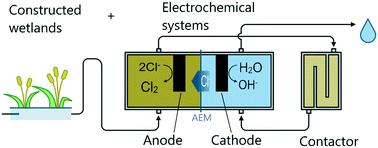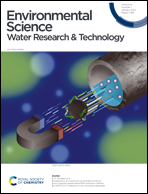Disinfection of constructed wetland effluent by in situ electrochemical chlorine production for water reuse†
Abstract
Constructed wetlands (CWs) are globally used for the treatment of wastewater. Due to various causes, often the water is not fully treated in terms of pathogen removal, requiring additional treatment. Here we evaluated the electrochemical disinfection (ED) of CW effluents to guarantee safe wastewater reclamation in decentralized settings. We used a two-chamber electrochemical cell to produce chlorine at a Ti/RuO2 anode with a synthetic electrolyte containing 18.3 mol Cl− m−3 and subsequently tested it with CW effluents from two locations (Ecuador and Belgium). The effluents ran first to the anode for disinfection by chlorine and then to the cathode for recovering a circumneutral pH. Different flow rate, current density, and membrane type combinations were tested with the synthetic electrolyte to optimize chlorine production and later to disinfect CW effluents. The system produced about twice as much free chlorine when an anion exchange membrane was selected rather than a cation exchange membrane because of chloride electromigration to the anolyte. A 5-log removal of fecal indicators was observed without pathogen regrowth within 7 days after treatment when residual chlorine remained, allowing for non-potable water reuse. Lower residence times (15 s) and current densities (50 A m−2) induced the most energy-efficient operation with a charge density of 10.4 A h m−3 and an energy consumption of <0.1 kW h m−3. These results encourage CW + ED use, especially in low-income countries.

- This article is part of the themed collection: Best Papers 2022 – Environmental Science: Water Research & Technology


 Please wait while we load your content...
Please wait while we load your content...